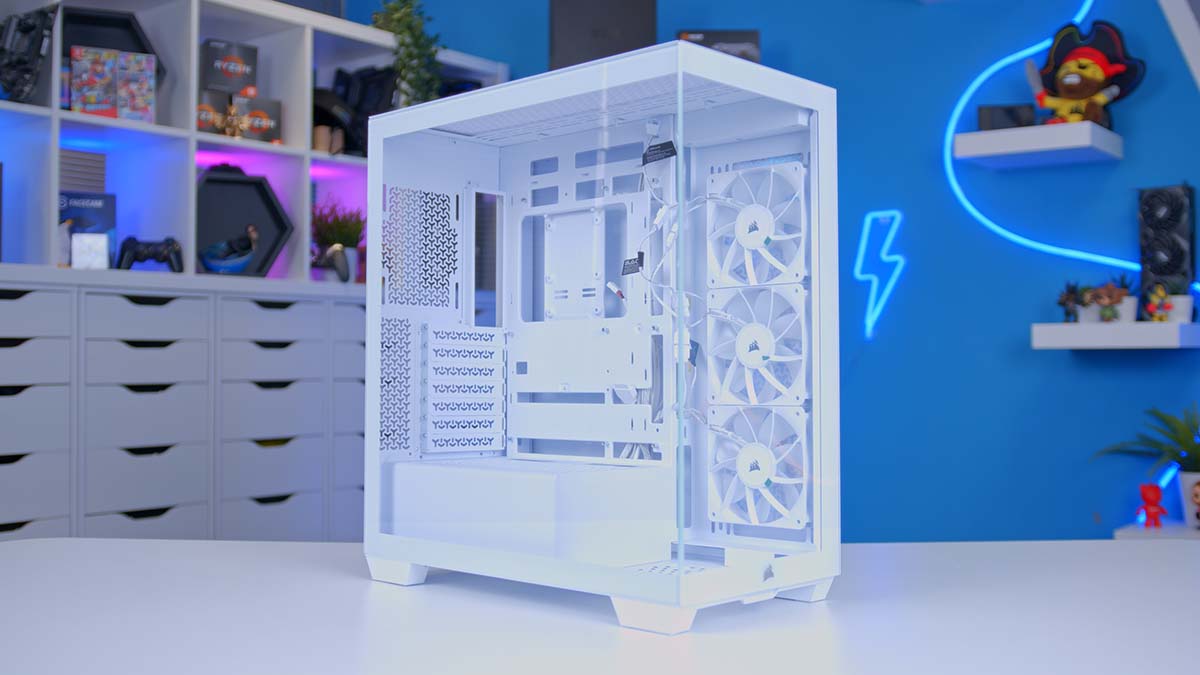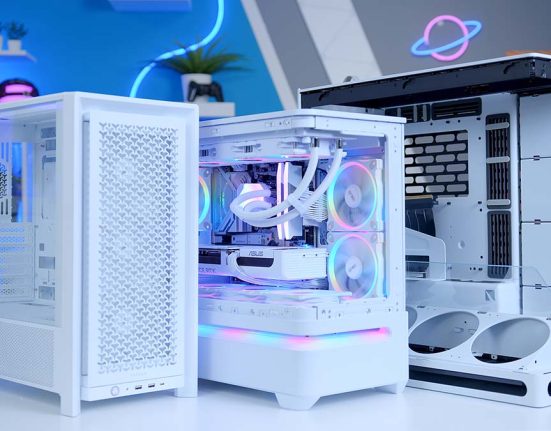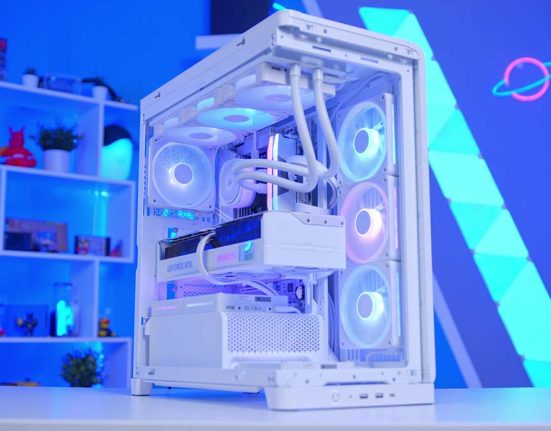The 3500X is a highly affordable chassis designed to offer that signature Corsair quality but at a competitive price versus market alternatives. Adopting the signature fish-tank style that we’ve seen many other manufacturers provide a spin on, the 3500X is a blend of the 6500X and 2500X ranges we saw released earlier in 2024. Specifically, it combines the affordable price of the 2500X while offering ample space of the larger 6500X. To see if this chassis is a worthwhile pickup, we’ve tested the Corsair 3500X rigorously to determine how it holds up during the building process and compares to other similarly priced options.
Corsair has been considered a premium case manufacturer for quite some time, with chassis like the 5000T, 4000X and 5000X ranges being top-rated a few years ago. However, with rising prices, Corsair has slowly drifted away from the ever-important budget price point, where manufacturers like DeepCool, Montech and Phanteks have been able to swoop in and provide solid alternatives at a much more competitive price.
This 3500X case looks to be Corsair’s re-entry into the budget space, directly competing with cases like the Phanteks NV5, the Montech King 65, which we saw at Computex, and other similarly priced fish-tank cases. In this review, we’ve assessed the Corsair 3500X in-depth, looking at its specs, design, building quality, and features.
Buy the Corsair 3500X ARGB on:
Specification
The Corsair 3500X is a mid-tower case that supports E-ATX motherboards, including compatibility with ASUS BTF and MSI PROJECT ZERO boards. Gigabyte PROJECT STEALTH is not mentioned as being supported here, but after using one with our 3500X build, we can clarify that they do fit.
While the 3500X is a mid-tower chassis, it’s pretty tall for a case of this stature. As a point of comparison, the Corsair 4000D was only 466mm tall, a whopping 40mm less than the 3500X. Corsair has likely made this case larger to accommodate the bottom fan, which isn’t typical of other mid-tower options.

This chassis comes in relatively standard black and white options. The white version we’ll look at today looks great with other white-themed parts. Component clearances are pretty standard for a mid-tower case. With space for GPUs up to 410mm long, there’s plenty of room for modern NVIDIA and AMD cards. The Corsair 3500X also accommodates CPU air coolers up to 170mm tall.
| Key Specs | Corsair 3500X |
|---|---|
| Form Factor | Mid-Tower |
| Motherboard Support | Mini-ITX, Micro-ATX, ATX, E-ATX |
| Case Dimensions (L x W x H) | 460mm x 240mm x 506mm |
| Front IO | 1 x USB 3.2 Gen2 Type-C 2 x USB 3.2 Gen1 Type-A 1 x 3.5mm Combo Jack |
| PCI-E Slots | 7 |
| Colour | White Black |
| Max Clearance | 170mm Cooler Height 410mm GPU Length 180mm PSU Length |
| Drive Support | Up to 2 x 2.5 inch Up to 2 x 3.5 inch |
| Fan Support | Top: 3 x 120mm Side: 3 x 120mm Rear: 1 x 120mm PSU Shroud: 2 x 120mm Bottom: 1 x 120mm |
| Radiator Support | Top: Up to 360mm Side: Up to 360mm Rear: Up to 120mm |
| Pre-installed Fans | 3500X: N/A 3500X ARGB: 3 x 120mm ARGB 3500X iCUE LINK RGB: 3 x 120mm iCUE LINK RGB |
| MSRP | 3500X: $89.99 3500X ARGB: $109.99 3500X iCUE LINK RGB: $149.99 |
The 3500X has great fan and radiator space. It can house up to ten 120mm fans. There is space for three fans along the bottom (two on the PSU shroud and one directly beneath the side panel), three on the side, three on the top, and one on the rear. As for radiators, the 3500X can squeeze in a 360mm AIO on the top and side panel, while the rear is limited to 120mm. It would be nice to see support for a 420mm cooler, but it would cause this case to be significantly larger than it already is.
The Corsair 3500X case has three different versions. The standard model has no RGB, no iCUE LINK, and no pre-installed fans, hence its $89.99 price point. The ARGB version, the next model up, sits at $109.99 and comes with three pre-installed addressable RGB fans. The last model at $150 is the iCUE LINK version, which features three pre-installed iCUE LINK fans on the front panel.

While I’m not a fan of the zero fans approach on the base model, those willing to save some money can buy relatively cheap fans for around $10-$20. I feel the ARGB model offers the strongest value, while the $150 iCUE LINK 3500X is teetering into mid-range territory. This is where cases like the Lian Li O11 Vision and Montech King 95 come into play, which may serve as better options depending on your preferences.
Corsair 3500X Design
As the introduction mentions, the Corsair 3500X is a fish-tank-style case with a seamless set of tempered glass panels on the front and side. I feel that this design philosophy has been overused recently, and unfortunately, the 3500X doesn’t deviate from the traditional metal box design, which doesn’t make it particularly unique in its look. This being said, from a glance, the 3500X does look sleek, and the white version offers consistent colouring across the entire chassis, including the front panel cables.
Both panels are toolless and can be easily removed by simply popping them out. The glass provides an unhindered view of all your components, showing them off without visual obstructions.

One of the more significant points of contention we often have with cases mostly made of glass is airflow. Fortunately, Corsair has done a decent job with ventilation. The entire bottom panel, including the PSU shroud, features large perforations, as do the top, rear, and opposing side panels.

These panels, which feature plenty of ventilation, are also equipped with filters to trap dust and minimise blockages. The dust filters are high-quality and don’t hinder airflow. It’s worth noting that only the bottom mesh is removable via the pull tab, while the top and side filters are stuck to the panel with magnetic tape.

The rear chamber of the case is relatively compact and looks far less spacious at first glance. However, as we’ll touch on later, as long as cables are managed appropriately, you shouldn’t experience any bulge. Corsair includes plastic ties funnelling from the top to the bottom of the case next to the PSU chamber. These will help builders tie up any mess to keep things clean.

You’ll also find the SATA drive mounting bay at the back of the case. This accommodates up to two 2.5-inch drives or two 3.5-inch drives for those with non-M.2 storage. This bay can be easily removed by loosening the thumbscrew beneath it, providing greater access to the motherboard tray and increasing cable management space.

One disappointing thing we did spot was the inherent lack of cable grommets. This won’t particularly matter to those not worried about cable management, but the lack of grommets means the cable mess is very visible. There isn’t much separation between the case’s front and back, which will restrict how clean you can make a build look inside this chassis. The rubber grommets are also pretty cheap to produce and place inside a case, so this feels like a missed opportunity.

PSU mounting is relatively standard for a case of this size. Corsair has created a raised portion inside the case to accommodate PSUs, with 180mm of space lengthways. This shroud keeps the PSU hidden, and builders can mount two 120mm fans on top, increasing airflow.

The front IO houses three USB ports: two USB 3.2 Gen1 Type-A ports and a single USB 3.2 Gen2 Type-C port. Prospective buyers can also use a 3.5mm combo jack for microphones and headsets.

Building in the Corsair 3500X ARGB
The Corsair 3500X ARGB’s design and specs look attractive, but a genuine test of quality can be conducted by building it. We configured an all-white powerful system inside this chassis with a Gigabyte AERO RTX 4070 SUPER and Gigabyte B650E AORUS STEALTH ICE motherboard, alongside a range of other fantastic white components.
Internal Space
Internal space is one of the critical strengths of the Corsair 3500X ARGB. As this case is slightly taller than most ATX tower options, it has extra space for a fan on the bottom of the chassis. After removing the tool-less glass panels, builders have unhindered access to all the internals, allowing you to move your hands freely.

All of the motherboard cutouts are wide and rounded, minimising the risk of damage to reverse connector motherboards. Additionally, we found that Gigabyte’s reverse connector range is supported in this case by using a PROJECT STEALTH board. The B650E AORUS STEALTH board easily slots into the case and feels secure once screwed down. The 3500X supports ATX boards straight out of the box, so there was no need to reconfigure any standoffs.

We installed the Gigabyte AERO RTX 4070 SUPER graphics card inside the 3500X ARGB. This card is 300mm long, so there’s an additional 110mm of clearance beyond its length. The card was installed horizontally, which meant there was space underneath the GPU for two 120mm fans, assisting thermals. Unfortunately, the 3500X doesn’t have an internal support bracket, but this isn’t a deal-breaker.

Moving to the rear, the cable management space is a bit more restrictive, but not to the point where it causes hassle. Builders will need to manage cables properly to avoid bulges, but there is 39mm of clearance and plenty of ways to channel the wires appropriately. We also decided to use a Corsair SHIFT power supply and found that the cables had a decent amount of space and that the headers were not at risk of sustaining damage through bending.

Radiator and Fan Mounting
The ARGB and iCUE LINK versions of the Corsair 3500X come with three fans installed on the side panel. For the ARGB model, these fans are the Corsair RS120 models and use the universal 3-pin ARGB header so that they can be plugged into any motherboard. While adding the RS120 fans is a nice touch, the wires are incredibly short. We felt that the fan cables were difficult to manage because of their length, resulting in a somewhat untidy look towards the right side of the case.
Furthermore, the lack of cable grommets on the side panel cutouts makes the cable mess look worse. A metal shroud or something similar would make this look more stylish.

Fans aside, the Corsair 3500X ARGB has two main panels for mounting coolers. The side (already taken up by three pre-installed fans) and the top panel accommodate 360mm liquid coolers. While the rear panel supports 120mm AIOs, it would be better to install a fan here instead.

The iCUE LINK Titan 360 RX was installed on the top panel, and I have to say, it looks fantastic. The fans are a bit more relaxed compared to the QX range, and while the pump block offers plenty of RGB, it doesn’t look as crazed as some of the other designs found on the earlier iCUE LINK coolers, such as the H150i. There’s plenty of space to install the cooler. Removing the top panel (which is tool-less) provides access to the mounting rails.

The magnetic iCUE LINK hub was attached to the drive mounting bays. Cables were managed easily at the back of the chassis using plastic ties to channel wires appropriately.

Two additional RS120 fans were mounted on the bottom and rear panels. As you can expect, the installation was straightforward, and because the cables were longer than those of the pre-installed fans, they were easy to hide away.

We decided not to mount fans on the PSU shroud in this configuration. While this would somewhat assist airflow, it wasn’t necessary for this build.

Ease of Building
Regarding the building process, James noted that the Corsair 3500X ARGB was easy to build in. There was nothing that overtly hindered the process. The case is spacious, there’s solid clearance across the board, and everything fits together nicely. Despite cable management looking like it might be tight, there’s a surprising amount of room. Even with the SHIFT power supply installed (which has the power cables facing towards the side panel), there was no risk of the bulge damaging the headers.
For a budget case, the Corsair 3500X ARGB feels premium. It’s sturdy, doesn’t look cheap, and builds well. However, there are a couple of quality points to discuss that we noted when building with this chassis. The first is the pre-installed fan cable length. This was touched on earlier, but it’s an odd choice to purposefully shorten the cables, as the lack of grommets makes them much more visible.
Furthermore, the PCI-E covers are incredibly thin. These metal covers aren’t supposed to be thick, but they need to be sturdy to minimise any potential damage when removing or reinstalling them. Quite simply, the metal is so thin that it can very easily bend. This won’t be a deal-breaker for some prospective buyers, but it feels cheap compared to the rest of the case, which is generally robust and highly resistant to damage or flexing.
Features We Like
Tool-Less Design
The vast majority of the 3500X case is tool-less. Both glass panels use a push-pin design and can easily be removed by simply pulling on them. The same design applies to the other side panel and top panel, neither of which are held in by screws and can be popped out. This will save some time and effort during the building process.

Single Front Panel Header
Front panel wires are often the bane of most PC builds, primarily because of the need to wire up the individual pins. Fortunately, the Corsair 3500X ARGB uses a unified header for the front panel pins. This means it can easily be plugged into JFP1, and you don’t need to worry about plugging them in a specific orientation.

Features We Don’t Like
Pre-Installed Fan Cable Length
The cable length of the pre-installed fans is too short. Because of their size, they’re challenging to manage and hide away. The lack of rubber grommets on the side panel cutout makes the headers very visible, which detracts from the overall design of your build. This was an odd choice from Corsair and ultimately limits how good a build can look.

Flimsy PCI-E Covers
It’s great to see a budget case that doesn’t provide single-use PCI-E covers, but they are incredibly flimsy. We found they bent very easily, and builders must exercise caution when installing or removing them.

Conclusion
Corsair 3500X ARGB
Product Name: 3500X ARGB
Brand: Corsair
-
Features
-
Design
-
Versatility
-
Value For Money
Summary
The Corsair 3500X ARGB case is a mid-tower chassis that is incredibly easy to build in. It is robust, feels premium, and provides a few quality-of-life features, such as the tool-less design and streamlined front panel cables that simplify the building process. There’s ample space for fans and large graphics cards, while the rear chamber has plenty of room to accommodate cables, including side-mounted PSUs like Corsair’s SHIFT range. Overall, it’s a solid value case that keeps things simple.
However, its simplicity is its biggest weakness. There aren’t any groundbreaking or particularly unique features that make it stand out. And while the 3500X is affordable, I feel that the ARGB version (available for $109.99) is better value than the cheaper $89.99 case that has no fans. At this price point, cases like the NZXT H6 Flow, Fractal Design North, and Phanteks NV5 become available, which offer interesting design traits that make them worth considering. Caveats aside, the Corsair 3500X ARGB provides decent value for those restricted by price and is worth considering if you’re looking for a simple and well-built chassis.
Pros
✅ Competitive pricing
✅ Mostly tool-less
✅ Easy to build in
Cons
❌ Short fan cables
❌ Flimsy PCI-E covers
❌ Limited 140mm support



![FI_[DM78] Corsair Air 5400 + 5090 Gaming PC Build](https://geekawhat.com/wp-content/uploads/2025/11/FI_DM78-Corsair-Air-5400-5090-Gaming-PC-Build-551x431.jpg)
![FI_[DP051] Antec C5 + 5070Ti Gaming PC Build](https://geekawhat.com/wp-content/uploads/2025/11/FI_DP051-Antec-C5-5070Ti-Gaming-PC-Build-551x431.jpg)


![FI_[DM76] HAVN BF360 5090 Build](https://geekawhat.com/wp-content/uploads/2025/10/FI_DM76-HAVN-BF360-5090-Build-1-551x431.jpg)
